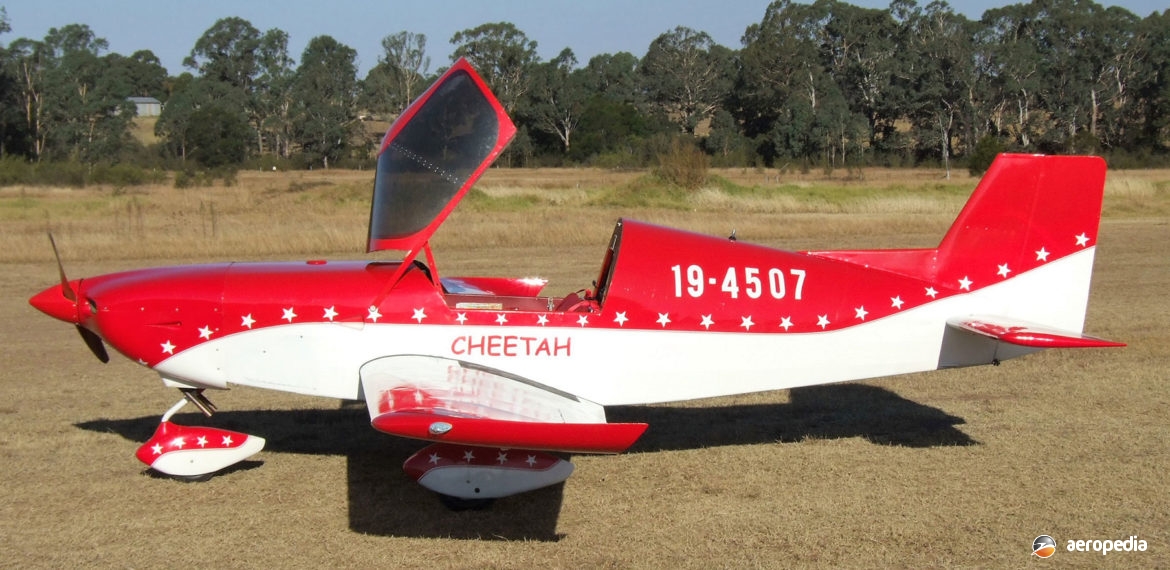Photograph:
The prototype Cheetah 19-4507 (c/n 01) at The Oaks, NSW in 2006 (David C Eyre)
Country of origin:
Australia
Description:
Two-seat light sporting monoplane
Power Plant:
One 60 kw (80 hp) Jabiru 2200 [2200 cc] four-cylinder horizontally-opposed air-cooled engine
Specifications:
- Wingspan: 7.55 m (24 ft 8 in)
- Length: 5.35 m (17 ft 7 in)
- Height: 1.8 m (5 ft 10 in)
- Tail span: 2.3 m (7 ft 7 in)
- Max speed: 232 km/h (144 mph)
- Cruising speed: 204 km/h (127 mph)
- Max rough air speed: 157 km/h (98 mph)
- Stalling speed: 72 km/h (45 mph)
- Take-off and landing run: 100 m (328 ft)
- Fuel capacity: 70 litres (15.4 Imp gals)
- Empty weight: 240 kg (529 lb)
- Max payload: 305 kg (672 lb)
- Loaded weight: 544 kg (1,199 lb)
History:
The Cheetah was designed by Garry Morgan of Miranda Investments as a high-performance light touring monoplane fitted with the Australian designed and built Jabiru 2200 cc engine, though other engines may be installed. Available in kit form, it may be fitted with engines in the 37 kw to 60 kw (50 hp to 80 hp) range. The fuselage is of aluminium tube with pop rivets. The main airframe holding the undercarriage, pilot and the wings are of welded steel tube framework. The wing spar is a structural angle, top and bottom, and is solid riveted. The ribs are of fibreglass and the aircraft is fabric covered to give a smooth finish. The engine cowling is of fibreglass, and it has fibreglass spats fitted to the wheels.
The aircraft was aimed at entry level for the amateur builder for a low-cost quick-build aircraft and may be fitted with a tricycle undercarriage or a tailwheel. The wings are quickly removable for trailering and storage. Baggage space is available behind the firewall and behind the seats; and a parcel shelf is available on top of this area. Fuel capacity is usually 70 litres (15.4 Imp gals) but wing tanks are available to provide an extra 80 litres (17.6 Imp gals). Cockpit width is 107 cm (42 in).
The prototype of this model (19-4507) was first flown on 1 March 2006 and at that time a number of kits were in the course of manufacture for amateur builders. Subsequently the Company set up a facility at Taree, NSW, becoming known as Morgan Aero Works, to manufacture its line of kit aircraft. In due course the Cheetah gave way to the Mk 2, this model having a 63 kw (85 hp) engine and a cruising speed of 204 km/h (127 mph) being available in kit form. Examples have been completed in New Zealand, including ZK-LLS and ZK-CCB, one being a Cheetah but it was completed as the later model, the Sierra.
In late 2007 a new development of the Cheetah appeared, this being the Sierra 100. It is similar in configuration, being a two-seat low-wing high-performance monoplane registered under RAA regulations. The prototype (19-5172) was flown for the first time in late 2007 and is powered by a 93 kw (125 hp) Jabiru 3300 cc six-cylinder engine. It has dual controls, is of all-metal construction, has Matco brakes, flaps and adjustments to fin sweepback, has electric trim, and has a max cruising speed of 250 km/h (155 mph). Work commenced in 2010 on a variant for flying schools to be registered in the 24- category, the first becoming 24-7634 and commencing flying training at a Taree based flying school. Engines ranging in power from 48 kw to 93 kw (65 hp to 125 hp) can be installed.
The type has become popular and by early 2014 more than 40 Cheetah and Sierra kits had been supplied. On 1 October 2011 24-7634 achieved some notoriety when it crashed into a ferris wheel at Old Bar Airstrip, NSW.
Cheetahs registered with RAA include: 19-5151 (c/n 19); 19-5155 (c/n 8); 19-5172; 19-5222 (c/n 16); 19-5233 (c/n 2); 19-5234 (c/n 3); 19-5362 (c/n 11); 19-5486 (c/n 6); 19-5511 (c/n 22); 19-7236 (c/n 33-S13); 19-7367 (c/n 25-S6); 19-7468 (c/n 38-S17); 19-7579 (c/n 6009); 19-7627 (c/n 36575); 19-7634 (c/n 41-520); 19-7807 (c/n 45-523); 19-7816 (c/n 12); 19-7955 (c/n 46-525); 19-8098 (c/n 345-14); 19-8137 (c/n 39-518); 19-8224 (c/n 37-S16); 19-8318 (c/n 10); 19-8335 (c/n 48-527); and 19-8443 (c/n 28-S6).
A further development was the Cheetah Sierra 200 which was the Type Certified model built with the Flying Training market in mind and registered in the VH category. In later years the Company ceased operations in Australia and the development and production of the series was taken over by Wedgetail Aircraft of Camden, NSW, the first of the new Wedgetail Cheetahs being fitted with a Lycoming O-320 engine.

